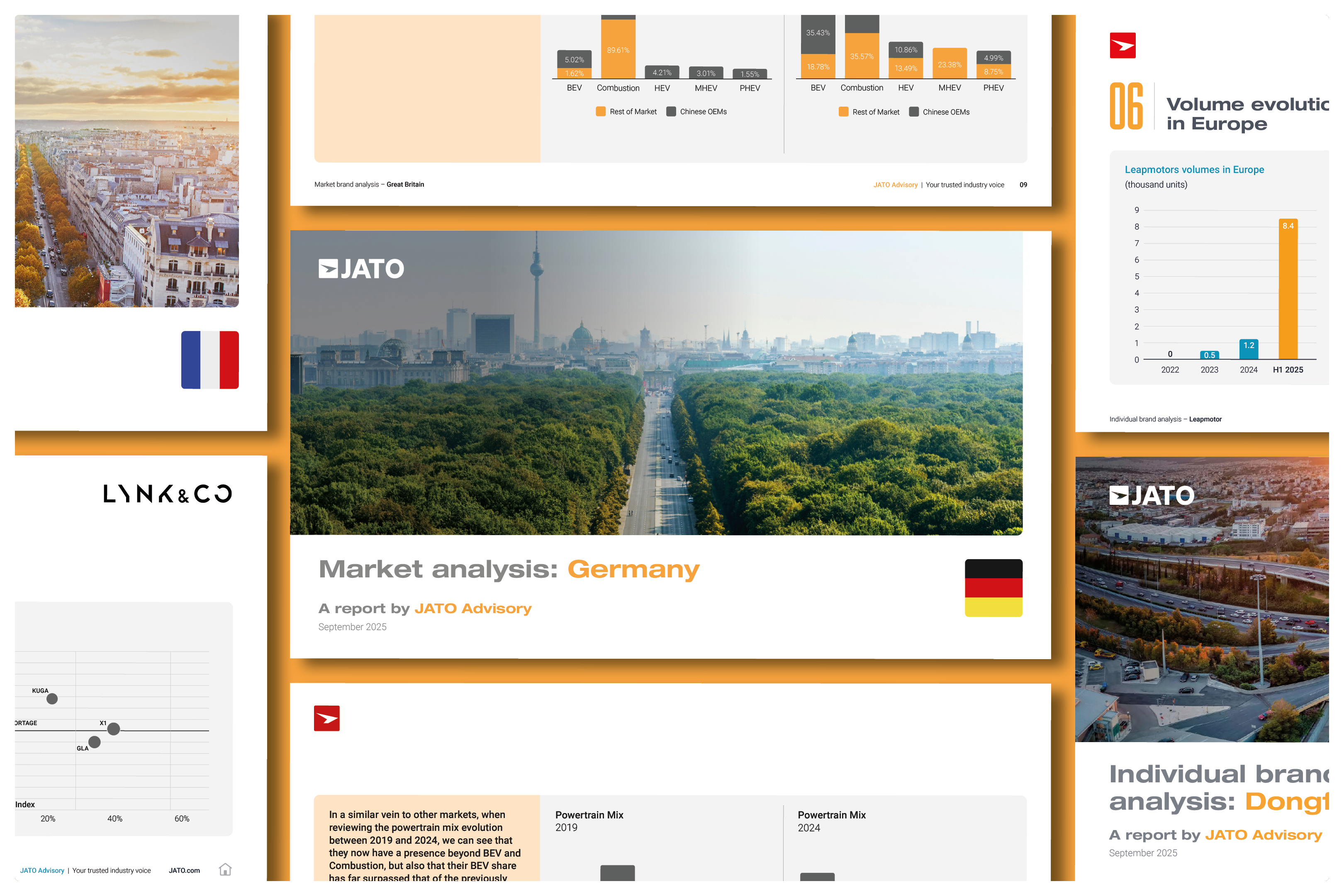Introduction
Part 1: The rise of Chinese OEM
China is the largest automotive market in the world. With over 23 million vehicles registered in 2024, it alone accounts for approximately 30% of global annual registrations. Until 2022, the Chinese market was predominantly led by foreign OEMs, making it a critical volume hub for foreign automotive brands such as Volkswagen, Toyota, and Honda.
However, a significant shift took place in the aftermath of the COVID-19 pandemic. From 2021 onward, Chinese brands started to regain momentum, ushering in what can be described as a renaissance for domestic manufacturers. By 2023, their combined volumes had reached parity with foreign brands, and in 2024, they decisively overtook them, capturing 59% of the local market share.
.jpg?width=1013&height=366&name=Chinese%20chart%20V2%20(1).jpg)
In absolute terms, this translates to 14 million vehicles registered by Chinese brands in their domestic market in 2024. This paradigm shift has not only redefined the competitive landscape within China but has also disrupted the global strategies of long-established Western players. Brands that once dominated the Chinese market for decades are now experiencing a decline in both volume and influence, as they are increasingly outpaced by agile and innovative local competitors.

Among the most symbolic shifts in this transformation is the loss of market leadership by Volkswagen, a brand that had dominated Chinese registrations for decades. Once the undisputed leader in the region, Volkswagen has seen its position eroded by the rapid ascent of domestic competitors. In 2023, BYD overtook Volkswagen, becoming the top-selling brand in China and in 2024 BYD has secured the 6th position globally among automotive groups by volume. A milestone that marks a turning point not only for the Chinese market but also for the global automotive hierarchy, as legacy players face increasing pressure from agile, tech-driven local manufacturers.
Beyond the shift in brand leadership, a deeper layer of transformation emerges when analyzing the evolution of powertrain technologies in China in relation to the origin of the brands. The Chinese automotive market is now strongly driven by New Energy Vehicles (NEVs)—a category that includes Battery Electric Vehicles (BEVs), Plug-in Hybrid Electric Vehicles (PHEVs), and Extended-Range Electric Vehicles (EREVs). In 2024, NEVs accounted for 45% of total registrations, marking a sharp contrast with more “traditional” internal combustion technologies (ICE, Mild Hybrid—MHEV, and Full Hybrid—HEV).
What is particularly striking is that this NEV surge is overwhelmingly led by domestic brands. In 2024, 9 out of 10 NEVs sold in China were produced by local manufacturers. This dominance not only positions China as the most advanced country in the global transition to electrified mobility, but also as the largest and most competitive market for these technologies, thanks to both the scale of demand and the intensity of local competition.
Rather than competing head-to-head with foreign OEMs on traditional combustion platforms, Chinese manufacturers strategically embraced electrification early on, using it as a lever to leapfrog legacy players. While many international brands continued to treat BEVs as a long-term alternative to ICE vehicles, Chinese OEMs fully committed to NEV development, investing heavily in innovation, vertical integration, and product diversification.
As a result, Chinese brands have not only secured leadership within their domestic market, but are now well-positioned to shape the global electric transition, setting new benchmarks in affordability, technology, and speed of execution.


Ready to dive deeper into Chinese brands in Europe?
This analysis sets the stage for understanding why Chinese automotive brands are positioned to transform the European market. But the real story lies in how they're doing it—market by market, brand by brand.
Our new 9-week series examines the strategies, performance, and competitive positioning of individual Chinese OEMs across key European markets. Each week, we'll deliver detailed brand and country analysis reports directly to your inbox.
Part 2: Chinese OEM and exports
While Chinese brands have continued to expand their presence in the domestic market, they have also experienced exponential growth in exports between 2019 and 2024. This surge has been driven by rapidly increasing production capacity, which not only supports high volumes in the domestic market but also enables a strategic shift toward international opportunities.
This expansion differs significantly from the historical global growth patterns of other Asian countries such as Japan and South Korea. The key differences lie in the sheer number of active players—our 2024 database records registrations for over 130 local brands in China—and the country’s unparalleled manufacturing capabilities.
The top three exporting brands in 2024 were:
- MG, accounting for 12% of total Chinese vehicle exports,
- BYD, with 7%, and
- Chery, contributing 5%.

Deep Diving the analysis into Chinese Automotive Exports, as of today, Chinese brands exports from China approximately 2.1% of global vehicle volumes. Their market penetration exceeds 10% in regions such as Oceania, the Middle East, and Africa. In other Asian countries, export volumes remain relatively low, despite strong performance in Russia — where many Chinese OEMs established local production during the Ukraine war. Here Chinese brands now hold nearly 50% market share, benefiting from the withdrawal of EU brands. Also in Southeast Asian Chinese brand share is growing steadily, however, their presence is still limited in key regional markets like India, Japan, and South Korea.
In the United States, Chinese vehicle exports are virtually non-existent, primarily due to high import duties imposed by U.S. administrations.
Europe, stands out as the leading destination for Chinese automotive exports, with over 300,000 units imported in 2024. Despite a current market penetration of just 2.5%, Europe represents the greatest opportunity for growth. This is largely driven by favourable import conditions for non-electric vehicles and a clear regulatory path toward electrification, allowing Chinese OEMs to leverage their advancements in New Energy Vehicles (NEVs).

Methodological Note
For the purposes of this white paper, it is essential to clearly define which brands are considered "Chinese" and which are regarded as retaining a "European" identity, despite any changes in ownership. This distinction is necessary to ensure analytical clarity when examining the dynamics of brand origin and market positioning.
It is also important to clarify that the use of the term “Chinese” throughout the study is intended solely to identify and analyze the growth of brands that are headquartered and developed in China. This terminology is used for descriptive and analytical purposes only, without any intent to assign labels or make value judgments.
European-born brand considered Chinese:
MG: Although it carries a historic British nameplate, MG was virtually absent from the European market prior to its relaunch by SAIC. Today, all MG platforms, models, and powertrains are developed in China, and the brand’s current identity is fully aligned with the strategic priorities of Chinese OEMs — particularly in the areas of electrification, affordability, and rapid product rollout. MG’s operational and technological backbone is entirely Chinese, making it representative of China’s new wave of global automotive players.
Smart: Since 2019, Smart has operated as a 50:50 joint venture between Mercedes-Benz AG and Zhejiang Geely Holding Group. Although Smart Europe GmbH is headquartered in Germany, production has shifted to China, and the brand now focuses exclusively on electric vehicles, adopting a new strategic direction, design language, and brand positioning. Given the introduction of the new line-up in 2023, Smart is considered a Chinese OEM from that date onward for the purpose of this study.
Chinese-owned brand considered European:
Volvo: maintains a strong strategic focus on the European market. Its product development, design language, and brand positioning remain deeply rooted in its Swedish heritage. The company continues to operate with a high degree of autonomy and is perceived by consumers and regulators alike as a European manufacturer.
Polestar: While co-owned by Geely and Volvo, Polestar was born in Europe and retains a brand identity that reflects its Scandinavian origins. Its design, engineering, and brand messaging are all consistent with its original European positioning.
Lotus: Despite undergoing a significant repositioning and product transformation, continues to emphasize its UK roots. This is clearly stated in official communications, such as this statement, which reaffirms the brand’s commitment to its British identity and heritage.
Other European brands associated with Chinese product:
DR Automobiles: it has been classified as a European brand. Founded by Massimo Di Risio in 2006, the company is headquartered in Macchia d'Isernia, Italy, and operates under full Italian ownership and management. While DR assembles and markets vehicles based on platforms and components sourced from Chinese manufacturers such as Chery, JAC, BAIC, and Dongfeng, the brand strategy, distribution, and final assembly are entirely managed in Italy.
EMC: it has been classified as a European brand. While leveraging Chinese manufacturing partnerships, EMC maintains a distinctly European identity. It operates as an Italian distributor and assembler of vehicles based on Chinese platforms, particularly from Dongfeng. The brand’s operations, marketing, and customer engagement are all managed from Italy, and its positioning is tailored to European consumers.
Ebro: it has been classified as a European brand. Originally a historic Spanish manufacturer of commercial vehicles, Ebro has been revived as part of Spain’s broader strategy to reindustrialize the automotive sector. The brand is now operated by Ebro-EV Motors, a Spanish-led consortium that took over the former Nissan plant in Barcelona. In 2024, Ebro entered into a joint venture with Chery to co-develop and produce vehicles at this facility. While Chery contributes technical platforms and production expertise, Ebro-EV Motors holds the majority stake and leads the brand’s strategic direction, design, and market positioning. The vehicles will be assembled in Spain, and the Ebro brand identity remains firmly rooted in its national heritage, with strong institutional support from the Spanish government.
Arrange a consultation today
Speak to a member of our team to discuss your requirements and find out how our bespoke consultancy solutions can help you meet your strategic goals.
